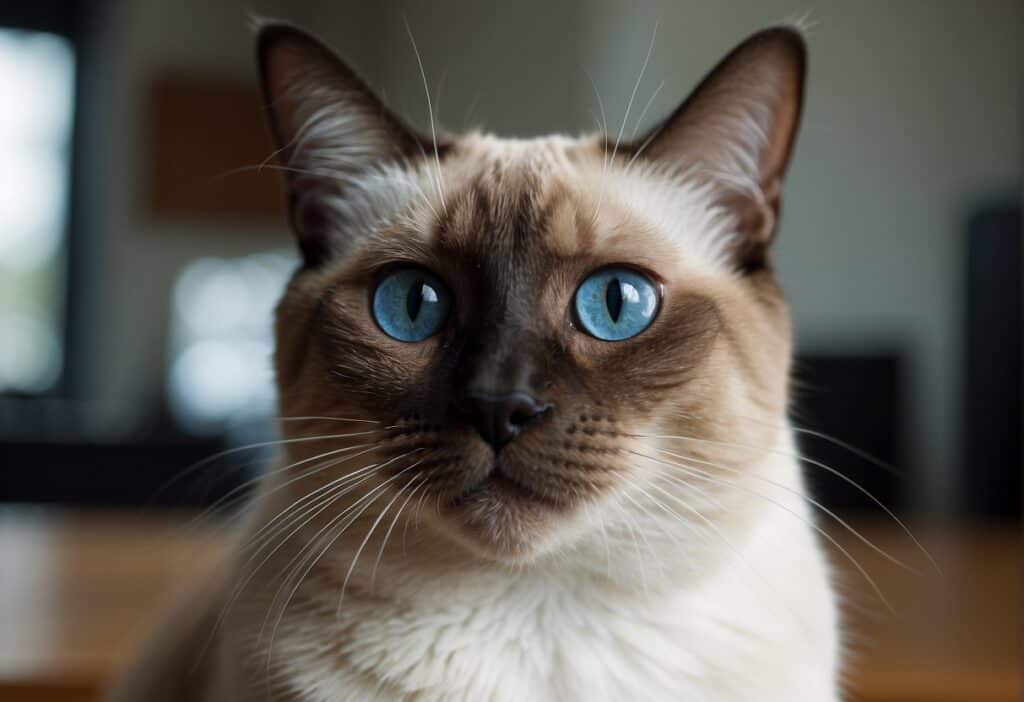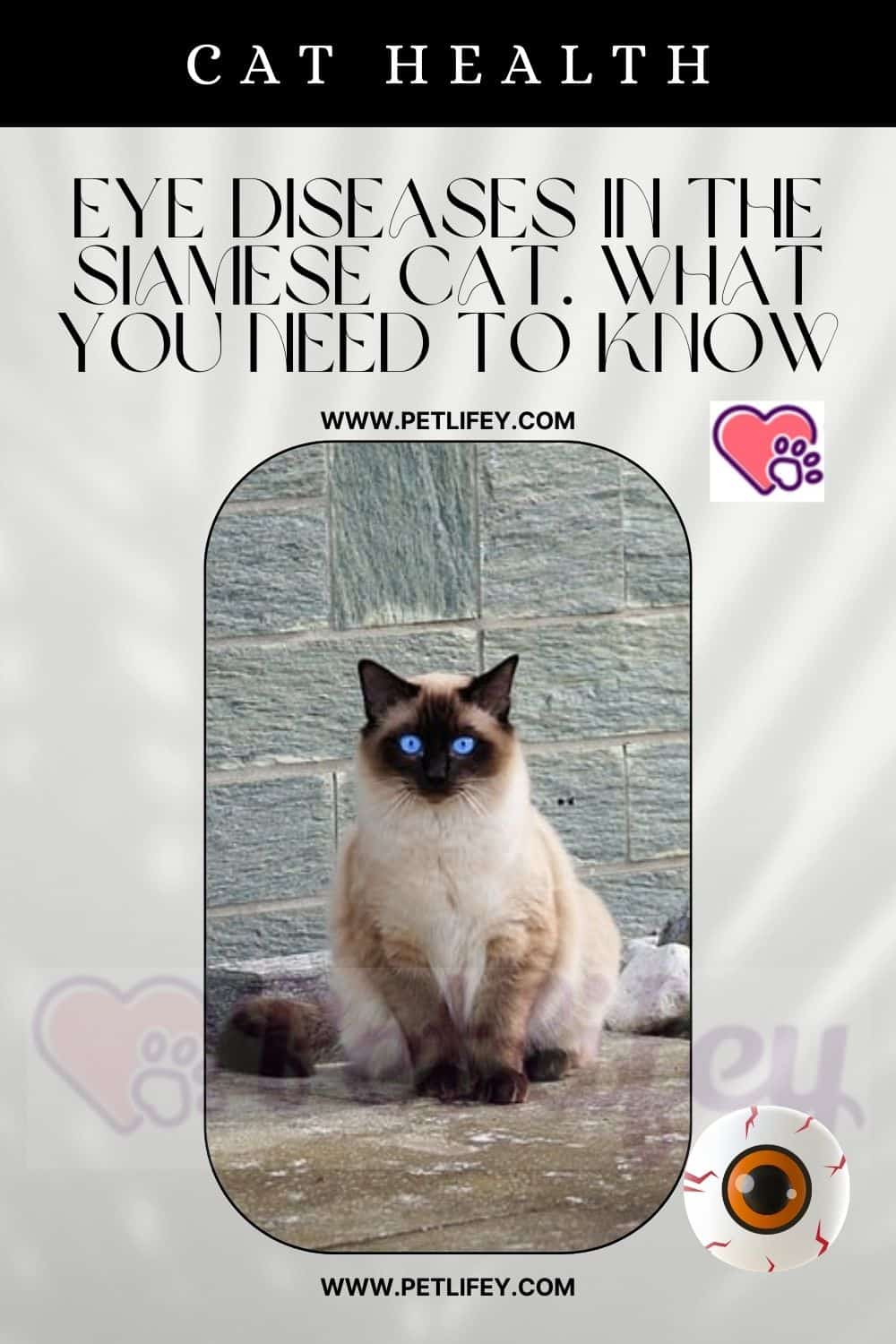Eye Diseases in the Siamese Cat: Essential Insights for Cat Owners

Siamese cats, with their striking blue eyes and elegant coats, are cherished pets known for their social nature. However, as a Siamese cat owner, you should be aware that these beautiful felines are predisposed to certain eye conditions that can affect their quality of life. Understanding the signs and preventative care for these issues is vital for maintaining the health and happiness of your Siamese cat.

Eye diseases such as progressive retinal atrophy can lead to gradual vision loss, while conditions like glaucoma involve increased pressure within the eye that can cause serious damage without treatment. Other common issues, including crossed eyes, a condition known as strabismus, and nystagmus, characterized by involuntary eye movement, are also found more frequently in Siamese cats. Identifying early symptoms like dilated pupils, redness, and excessive tearing will enable you to seek prompt veterinary care, increasing the likelihood of successful management or treatment of these conditions.
Your attentiveness to your Siamese cat’s eye health plays a crucial role in their overall well-being. Regular check-ups with a veterinarian skilled in feline ophthalmology are recommended to ensure that any signs of eye disease are caught and addressed at an early stage. With the proper knowledge and proactive care, you can help safeguard the vision and health of your Siamese companion.
Understanding Siamese Cats

When you consider a Siamese cat, it’s important to understand not only their distinct appearance but also the genetic factors that may influence their health. This breed has unique characteristics and genetic predispositions that can impact their overall well-being.
Breed Characteristics
Siamese cats are renowned for their elegant, slender bodies and striking almond-shaped blue eyes. A Siamese has a short coat with color mainly on their ears, face, paws, and tail, which contrasts with a lighter body. This pointed pattern is a hallmark of the breed. They are sociable and intelligent cats often known for their vocal nature and affectionate behavior.
Genetic Predispositions
Your Siamese cat is genetically predisposed to certain eye conditions that you should be aware of. The breed typically has deep blue eyes due to a gene that is also associated with some of these conditions:
- Crossed eyes (strabismus): A condition where the eyes do not align properly.
- Progressive Retinal Atrophy (PRA): Can lead to a gradual loss of vision due to retinal deterioration.
These traits are linked to the Siamese genes, and while they add to your cat’s unique appearance, they also require attentive care and regular veterinary check-ups to manage any potential health issues that may arise.
Common Eye Conditions in Siamese Cats
Siamese cats are predisposed to several eye conditions that can affect their quality of life. As a Siamese cat owner, you should be aware of these common eye issues, their symptoms, and potential treatments.
Convergent Strabismus
Convergent strabismus, often referred to as crossed eyes, is a condition where your Siamese cat’s eyes might appear to be pointed toward the nose. This genetic trait does not necessarily impair vision but should be monitored for any changes that may indicate other health issues.
Progressive Retinal Atrophy
Progressive Retinal Atrophy (PRA) is a degenerative disease affecting the retina, which can lead to vision loss and potentially night blindness in your cat. PRA is not painful, but early detection is key to managing the condition effectively.
Nystagmus
Nystagmus is characterized by involuntary, jerking movements of your cat’s eyes. There are two main types: jerk nystagmus where the eyes move slowly in one direction and quickly in the other, and pendular nystagmus where movements are equal in speed and direction. This condition might be present at birth or develop later in life due to neurological problems.
Glaucoma
Glaucoma occurs when there is increased pressure in the eye due to fluid buildup, potentially damaging the optic nerve and leading to vision loss. Symptoms to look out for include redness, tearing, or a dilated pupil in one or both eyes. Early treatment can help preserve your cat’s sight.
Symptoms and Diagnosis
Siamese cats can exhibit a range of symptoms indicative of eye problems, and timely diagnosis by a veterinarian is crucial to maintaining your feline’s vision and health. Awareness of symptoms and signs, coupled with professional clinical examination, forms the cornerstone of detection and management of eye conditions.
Early Detection
To ensure the well-being of your Siamese cat’s eyes, watch for early signs of eye problems such as excessive tearing, discharge, redness, or swelling. Other indicators include squinting and eye discomfort, which may suggest an underlying issue. If your cat is exhibiting vision problems such as bumping into objects or if you notice dilated pupils, these too need prompt attention.
Clinical Examination
When presented with these symptoms, a veterinarian will perform a comprehensive clinical examination to diagnose the condition. This may include:
- Visual inspection: assessing for visible signs such as discharge, weepiness, or dry eye.
- Palpation: checking for abnormalities in eye structure or surrounding tissues.
- Opthalmoscopy: a closer look at the internal structures to identify any congenital eye conditions or changes associated with diseases.
- Tonometry: measuring eye pressure to rule out glaucoma, a condition that can cause blindness.
It’s essential that you consult your veterinarian for an accurate diagnosis and appropriate treatment to safeguard your Siamese cat’s eyesight.
Treatment Options
In addressing eye diseases in Siamese cats, your arsenal consists of medical treatments that alleviate symptoms and surgical interventions designed to resolve underlying issues. Depending on the condition, these strategies aim to restore your cat’s eye health effectively.
Medical Treatments
For conditions like conjunctivitis or corneal ulcers, antibiotics play a pivotal role in combating infections. Your veterinarian may prescribe antibiotic drops or ointments directly applied to your cat’s eye. Artificial tears can be used to keep the eyes moist and soothe minor irritations. For certain inflammatory conditions, anti-inflammatory medications and pain relief may also be necessary. If your cat is diagnosed with an eye condition resulting from a deficit in nutrition, a regimen of vitamins and supplements might be recommended to support overall eye health.
Surgical Interventions
When medical management is not enough, surgery may be the course of action. Conditions such as glaucoma, if severe, might need a surgical approach to reduce the intraocular pressure or to remove the affected eye (enucleation) to relieve pain and prevent further complications. Strabismus, where the eyes are not properly aligned, might also be corrected with surgery if it causes significant problems for your cat. In the case of cataracts, which cause clouding of the lens, cataract extraction could potentially restore vision, although this depends on the overall health of the retina and other eye structures.
Complications and Management
Effective management of Siamese cat eye conditions requires understanding the potential complications and appropriate care strategies. Your knowledge and vigilance can significantly impact your cat’s quality of life.
Living with Vision Impairment
If your Siamese cat is experiencing vision loss due to progressive retinal atrophy or other eye diseases, it’s crucial to maintain a consistent environment. Abrupt changes to the layout of your home can disorient a visually impaired cat. It’s also important to keep pathways clear of obstacles that could cause injury. Regular visits to a veterinarian are essential to monitor the health of your cat’s eyes and adapt their care regimen as needed.
- Environmental Safety: Create a safe zone with easy access to food, water, and litter.
- Familiarity: Avoid rearranging furniture to maintain a consistent layout.
- Consistency in care: Keep their routine for feeding and playtime predictable.
Preventing Further Damage
Prevention of further eye damage involves early detection and treatment of potential health problems. Regular check-ups can identify conditions like glaucoma or conjunctivitis before they lead to serious complications.
- Protection from Allergens: Reduce exposure to potential allergens that may cause inflammation or watery eyes.
- Avoidance of Bright Light: Siamese cats with eye conditions may have increased sensitivity to light, so providing shaded areas or dimming the lights can offer relief.
- Regular Veterinary Exams: Early detection is key for managing health issues, so ensure you schedule and keep regular veterinary appointments.
By actively managing your Siamese cat’s eye health, you can help prevent complications and provide a comfortable life, even with vision impairment.
Breeding and Genetics
When considering Siamese cats, your understanding of their particular genetic makeup is crucial, especially because certain eye conditions are linked to their distinctive traits. Genetic testing and responsible breeding practices are key to maintaining the breed’s health.
Genetic Testing
Genetic testing can identify the presence of specific genes that may result in health issues for Siamese cats. For example, the albinism gene, also known as the cs gene, is directly responsible for the breed’s characteristic blue eyes and coat color. This gene affects melanin production and can lead to a form of albinism that is thermolabile, meaning the coat lightens or darkens in response to temperature changes. Understanding the genetics behind this characteristic can help in identifying recessive diseases.
- Purpose of Testing: Determine the risk of birth defects and other health issues.
- Process:
- DNA sample collection, typically through a cheek swab.
- Analysis of genetic markers for specific conditions.
Responsible Breeding Practices
Responsible breeding practices play an essential role in mitigating health risks associated with the breed’s genetic predispositions. Siamese cats carry a recessive gene that may lead to certain eye conditions; therefore, mating pairs should be chosen with an understanding of their genetic heritage.
- Best Practices:
- Always conduct genetic tests before breeding.
- Avoid mating individuals with known recessive disease risks.
- Monitor the incidence of birth defects and adjust breeding strategy accordingly.
Employing these measures ensures the long-term health and vitality of the Siamese breed, allowing prospective owners to enjoy their companionship free from preventable hereditary issues.
Additional Eye-Related Concerns
While some eye issues are genetic, Siamese cats may also experience various additional eye-related concerns. Some of these are due to infectious diseases, while others stem from structural abnormalities. Knowing these conditions can help you detect and manage them early.
Infectious Diseases
Conjunctivitis: You may notice your Siamese cat’s eyes appear red and swollen—a condition known as conjunctivitis. It can result from bacterial infections or viruses, such as the feline herpesvirus.
- Symptoms: Eye redness, discharge, squinting
- Treatment: Depends on the cause; antibiotics for bacterial infections, antiviral medication for viruses
Feline Herpesvirus: This common respiratory disease can affect your Siamese cat’s eyes, causing conjunctivitis and corneal ulcers.
- Symptoms: Sneezing, nasal discharge, eye discharge
- Treatment: Supportive care, antiviral drugs, keeping the eyes clean and moist
Structural Abnormalities
Cataracts: Your Siamese cat can develop cataracts, where the lens becomes cloudy, potentially leading to vision loss.
- Symptoms: Cloudy or opaque lens, bumping into furniture
- Treatment: Surgical removal may be necessary for severe cases
Feline Convergent Strabismus: A condition where a Siamese cat’s eyes cross or deviate inwards.
- Symptoms: Noticeably crossed eyes
- Treatment: Surgery in severe cases; many cats adapt to mild strabismus
Eyelid Mass or Tumors: Eyelid growths can cause discomfort and may require removal if they obstruct vision or are cancerous.
- Symptoms: Visible mass, rubbing or pawing at the eye
- Treatment: Surgical removal and biopsy
Excessive Tearing and Blocked Tear Ducts: Signs of blocked tear ducts include excessive tearing or discharge.
- Symptoms: Wet fur around the eyes, discharge
- Treatment: Cleaning the area, tear duct flushing, surgery if necessary
Third Eyelid Prolapse: Siamese cats may show a visible third eyelid, which could be due to injury, infection, or other health issues.
- Symptoms: Third eyelid covering part of the eye, discomfort
- Treatment: Addressing the underlying cause, surgery in rare cases
Caring for a Siamese Cat with Eye Issues
Proper care for a Siamese cat with eye issues involves regular veterinary assessments and a tailored home setting. As a responsible cat owner, your vigilance and proactive management can significantly improve your cat’s quality of life.
Regular Check-Ups
Regular check-ups are crucial in detecting changes or the progression of eye conditions in your Siamese cat. Early detection of issues such as eyelid masses, dilated pupils signaling potential glaucoma, or signs of trauma can be pivotal in successful treatment.
- Initial Screening: A comprehensive eye exam can detect conditions like cataracts or iris changes.
- Follow-Up Visits: Monitor for any signs of worsening vision, changes in eye appearance, or unusual blinking, and schedule visits accordingly.
- Emergency Situations: Immediate veterinary attention is necessary if your cat shows sudden signs of distress, such as squinting or pawing at their eyes, which could indicate acute trauma or the presence of cancer.
Creating a Safe Home Environment
Minimizing hazards in the home is important to protect your Siamese cat from eye injuries that can exacerbate existing conditions.
- Remove Harmful Objects: Keep sharp objects, chemicals, and small items that can cause eye injuries or irritation out of reach.
- Cat-Proofing Spaces: Soften or pad sharp corners on furniture and ensure there are no areas where your cat could accidentally harm their eyes.
- Stress Reduction: A calm and predictable environment helps reduce the risk of trauma from skirmishes with other pets or accidents resulting from high-stress situations.
By maintaining a diligent eye care routine and a safe living space, you can help manage your Siamese cat’s eye health effectively.







